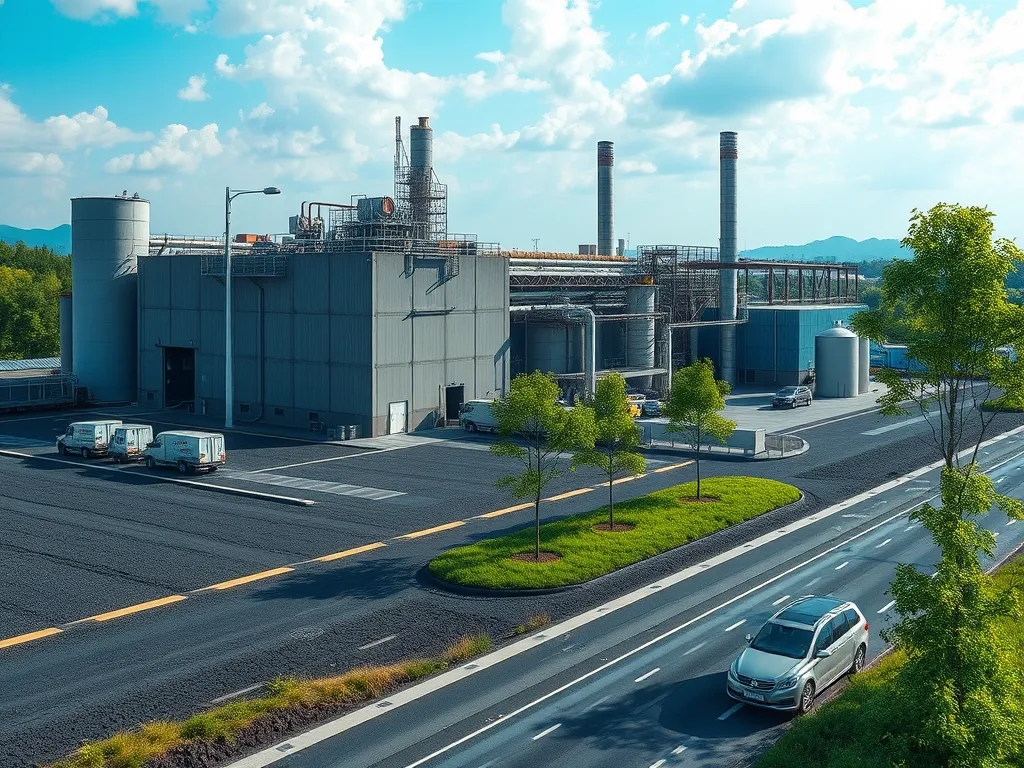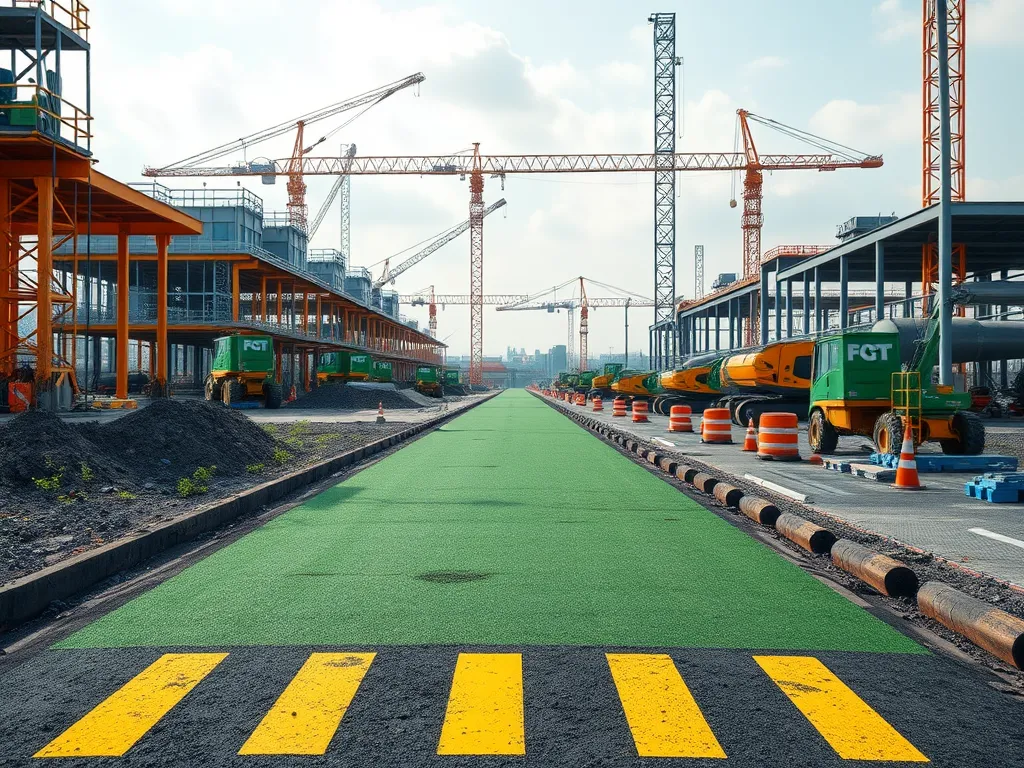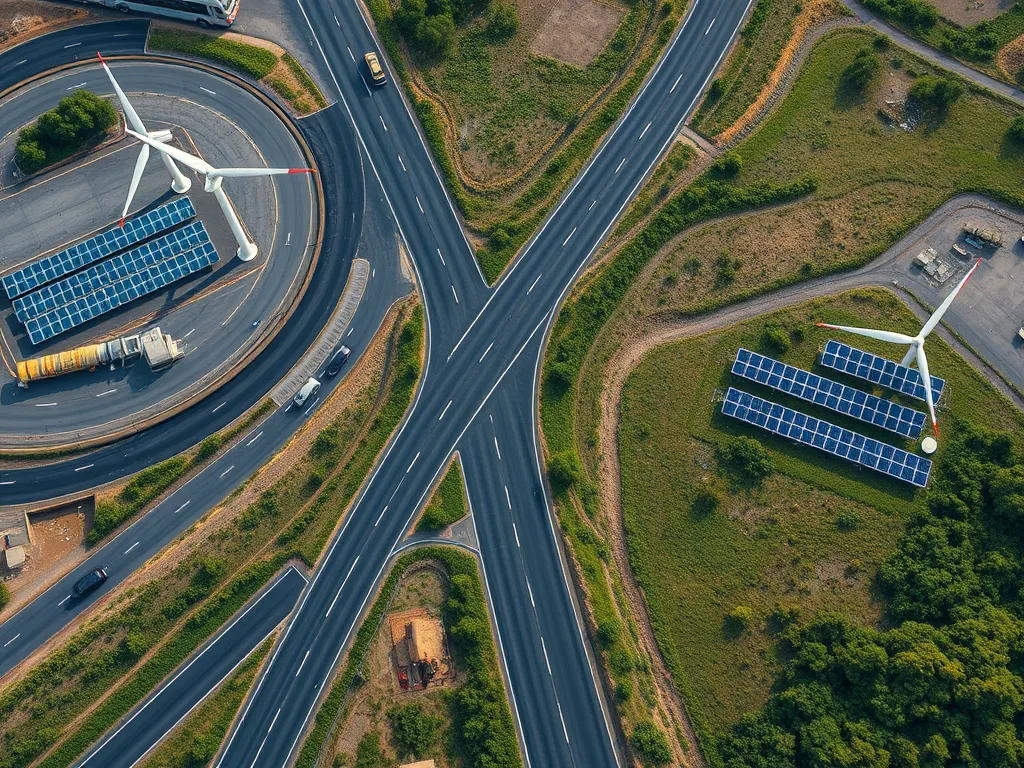Carbon-neutral Asphalt Production: Paving Roads Without Harming the Planet
Published on: October 8, 2025 | Last Updated: April 14, 2025
Written By: George Voss
Carbon-neutral asphalt production balances pavement creation with environmental protection by eliminating net greenhouse gas emissions. This process combines recycled materials like Reclaimed Asphalt Pavement (RAP), bio-based binders, renewable energy sources, and carbon offset programs. Unlike traditional methods emitting 30-40 kg of CO2 per ton of asphalt, carbon-neutral approaches aim for net-zero emissions through cleaner technologies and waste reduction. It maintains asphalt’s strength while cutting environmental harm.
This guide explains how sustainable asphalt works. You’ll learn production methods using solar-powered plants or waste cooking oil as fuel. We’ll break down cost comparisons between conventional and eco-friendly mixes, including tax credits for using 30%+ RAP. Case studies show real-world success in highways and airport runways. Answers to key questions address durability, costs, and retrofitting existing plants. By the end, you’ll know how the industry builds roads that last decades without worsening climate change.
Contents
- What is Carbon-neutral Asphalt Production?
- How is Carbon-neutral Asphalt Produced?
- Benefits Of Carbon-neutral Asphalt
- Costs for Carbon-neutral Asphalt
- Regulatory Framework for Sustainable Asphalt Production
- Case Studies in Carbon-neutral Asphalt Implementation
- Environmental and Safety Considerations
- FAQs About Carbon-neutral Asphalt Production
- Closing Thoughts
- Additional Resources for You:
What is Carbon-neutral Asphalt Production?
Carbon-neutral asphalt production balances emissions generated during manufacturing with methods to eliminate or counterbalance them. This approach targets net-zero carbon dioxide output across the entire lifecycle—from material sourcing to pavement placement.
Defining Carbon-neutral Asphalt
Carbon-neutral asphalt refers to mixes achieving net-zero emissions through recycled materials, renewable energy, and carbon capture. Key components include Recycled Asphalt Pavement (RAP) reused at 95% rates, bio-based binders like lignin or algae, and solar-powered plants. Technologies such as carbon capture systems in drum mixers trap 50-70% of process emissions. Lifecycle assessments verify emissions parity with removal efforts, making these pavements part of climate action plans.
Key Objectives Of Sustainable Asphalt Production
The industry focuses on three targets: slashing greenhouse gases by 20% before 2030, boosting RAP usage to 40% nationwide, and cutting energy use 15% via warm-mix asphalt tech. The National Asphalt Pavement Association aims for full carbon neutrality by 2050. Plants now track emissions using tools like the Environmental Product Declaration, while recycled materials trim costs 25-30% per ton. Every 10% RAP added reduces emissions 1.5 tons per mile.
With these frameworks in place, let’s examine the methods turning these targets into pavement.
How is Carbon-neutral Asphalt Produced?
Carbon-neutral asphalt combines innovative materials with cleaner processes to balance emissions. Producers use three core strategies: eco-friendly raw materials, energy-smart methods, and direct carbon management.
Raw Materials for Low-carbon Asphalt
Reducing emissions starts with rethinking ingredients. Sustainable mixes minimize virgin resources while maintaining strength.
Recycled Asphalt Pavement (RAP) Integration
RAP replaces up to 40% of new materials in mixes. Reusing milled pavement slashes mining needs by 30% per ton. Modern plants now process RAP at lower temps (250-275°F vs. 300°F), cutting fuel use by 20%.
Bio-Based Binders and Additives
Traditional bitumen generates 2.1 kg CO₂ per ton. Bio-binders like lignin (from wood pulp) or soybean oil lower this by 15-30%. Some plants test rubber-modified binders with recycled tires, diverting 220 million tires yearly from landfills.
Energy-efficient Production Methods
Producers shrink energy demands through tech upgrades and fuel swaps. These changes trim plant emissions by up to 50%.
Renewable Energy in Asphalt Plants
Solar panels now power 12% of U.S. plants’ conveyor systems. Wind turbines support heating in Nordic facilities, while geothermal preheating cuts mix temps by 35°F in trials.
Biofuels for Heating and Mixing
Biodiesel blends (B20-B50) replace diesel in drum dryers. Tests show 18% lower particulates with zero sulfur content. Biomass burners using wood chips cut heating costs by $8 per ton.
Carbon Capture and Offsetting in Asphalt Manufacturing
Even with reductions, residual emissions need balancing. Carbon capture systems (CCS) trap 65-90% of flue gases. One Texas plant injects 12,000 tons yearly into concrete curing. Offsetting programs fund urban tree planting—1 mile of road requires 80 trees to neutralize emissions.
These methods set the stage for exploring how eco-friendly asphalt outperforms traditional mixes—both for the planet and budgets.

Benefits Of Carbon-neutral Asphalt
Shifting to carbon-neutral asphalt brings gains for both our world and infrastructure systems. This forward-thinking strategy tackles climate impacts while boosting road quality and fiscal responsibility.
Planet-positive Gains From Sustainable Asphalt
Low-carbon mixes slash CO2 output by up to 30% compared to standard hot-mix asphalt. Using 95% recycled asphalt pavement (RAP) in projects cuts mining of virgin aggregates. Bio-binders from plants like switchgrass or algae replace 15-20% of fossil-based bitumen. Solar-powered batch plants now operate at 100% renewable capacity, nullifying carbon discharge during mixing.
Fiscal Upsides Of Green Production
RAP integration drops material costs by $8-$15 per ton. Tax credits through initiatives like the Inflation Reduction Act cover 30% of solar panel installations at mixing facilities. A 2023 study found highways using carbon-neutral pavement required 40% less maintenance over 10 years, saving $2.1 million per lane mile.
Performance Strengths in Low-carbon Mixes
Modified binders with graphene additives boost rutting resistance by 65% in trials. Warm-mix methods compact roads 3x faster, creating tighter molecular bonds. California’s I-710 project reported 22% fewer cracks in carbon-neutral lanes after 5 years of heavy truck traffic. These pavements withstand temperature swings from -20°F to 150°F without structural compromise.
With proof points mounting across infrastructure sectors, attention now turns to balancing upfront costs against lasting value. Upcoming analysis breaks down fiscal models making sustainable asphalt viable for all project scales.
Also See: Cold Mix Asphalt and Road Safety: A Smart Solution
Costs for Carbon-neutral Asphalt
Shifting to green asphalt needs smart cost plans. New tools and methods may cost more at first. But long-term gains often beat these starts.
Start-up Costs Vs. Future Gains
New plants with carbon traps or bio-binders cost 15-25% more than old ones. Solar or wind power adds $500k-$2M per site. But using 40% RAP cuts mix costs by $8-$12 per ton. Over ten years, plants save 20-30% on energy and upkeep. Roads last 30% longer, slashing fix costs by up to half.
Cash Help for Green Asphalt Jobs
The U.S. offers tax breaks and grants for low-carbon pavement work. The Inflation Cut Act gives 30% back on carbon capture gear. EPA grants pay up to $5M for RAP use in city jobs. State plans add $3-$15 per ton for mixes with recycled stuff. Carbon credits earn $10-$50 per ton stored. Some banks give low-rate loans for plants that cut CO2 by 40%+.
With funds and future saves in view, rules form the next key piece in green asphalt growth.

Regulatory Framework for Sustainable Asphalt Production
Building carbon-neutral asphalt requires alignment with evolving regulations. Agencies worldwide now set measurable targets to cut emissions from pavement materials while maintaining performance.
Current Standards for Asphalt Carbon Neutrality
The asphalt industry follows three primary frameworks to verify carbon neutrality:
- ISO 14067: Measures product carbon footprints, requiring asphalt producers to report emissions from raw materials to installation
- EN 15804+A2: European standard mandating 20-30% lower CO₂e in asphalt mixes by 2030, using life cycle assessment (LCA) methods
- EPD (Environmental Product Declarations): Third-party certifications like Climate Declared track asphalt’s global warming potential (GWP) per ton
Projects aiming for net-zero status must offset residual emissions through verified programs like Verra’s Verified Carbon Standard.
Government Policies Supporting Low-carbon Pavement
Legislation drives adoption of eco-friendly asphalt through mandates and funding:
- U.S. Inflation Reduction Act: Allocates $2.6 billion for low-embodied carbon pavement, with tax credits covering 30% of plant upgrades
- EU Green Deal: Requires 50% RAP usage in member states’ road projects by 2027, paired with penalties for non-compliance
- California Buy Clean Act: Caps asphalt’s GWP at 90 kg CO₂e per ton for state-funded projects, pushing bio-binders and electric drum plants
Local policies add pressure: New York City mandates 75% recycled content in asphalt, while Texas offers $8/ton rebates for mixes with 40% RAP.
These rules shape how engineers design roads – a shift evident in real-world projects now redefining infrastructure standards globally.
Case Studies in Carbon-neutral Asphalt Implementation
Urban Road Projects Using Sustainable Asphalt
Los Angeles repaved 50 miles of city roads using 95% recycled asphalt pavement (RAP) and bio-binders from plant oils. This cut CO2 by 1,800 tons per mile. Solar-powered plants heated mixes at 50°F lower temps. Cool pavement coatings slashed street heat by 12°F, easing urban heat islands.
Airport Runways With Carbon-neutral Pavement
Amsterdam Schiphol Airport laid a runway with 30% RAP and 70% new eco-friendly asphalt. Wind power ran the plant, and biofuel cut heating emissions 40%. Low-temp PG 76-22 binder handled 500 daily flights. The mix passed FAA tests for load and wear, proving green asphalt works under heavy stress.
Highway Construction With Recycled Asphalt
Texas rebuilt 22 miles of I-35 using 50% RAP and warm-mix additives (WMA). This saved 25,000 tons of new rock and 18% fuel costs. Emissions dropped 25% versus standard methods. The road showed 30% better rut resistance in 3-year checks, per TxDOT reports.
| Project | RAP Used | CO2 Cut | Key Tech |
|---|---|---|---|
| LA Roads | 95% | 1,800 tons/mile | Bio-binders, solar heat |
| Schiphol Runway | 30% | 40% | Wind power, low-temp mix |
| Texas I-35 | 50% | 25% | WMA, high RAP |
These cases prove carbon-neutral asphalt works at scale. Yet plant upgrades and material costs still pose hurdles. Next, we’ll break down how rules and safety steps shape green asphalt growth.

Environmental and Safety Considerations
Shifting to carbon-neutral asphalt requires balancing industrial activity with planetary and human well-being. This part looks at tactics to shrink pollution footprints and safeguard populations living near mixing hubs.
Reducing Asphalt Plant Outputs
Modern hubs cut CO2 output by up to 40% using three main tactics:
- Mixing at 280°F (138°C) instead of 320°F (160°C) slashes fuel consumption
- Solar thermal systems powering drum dryers
- Carbon capture units trapping 95% of CO2 from flue gas
Biofuels like tall oil pitch now fuel 22% of U.S. plants, trimming fossil dependency. Hybrid models combining RAP (Recycled Asphalt Pavement) with bio-binders show 15-18% lower GHG profiles than virgin mixes.
| Method | CO2 Output (tons/year) | Fuel Type |
|---|---|---|
| Traditional | 12,000 | Diesel |
| Green | 7,200 | Biofuel/Solar |
Community Health Near Asphalt Production Facilities
Plants using carbon-neutral methods report 60% lower VOC (Volatile Organic Compound) levels versus standard operations. Key upgrades driving this shift:
- Closed-loop RAP crushing cuts PM2.5 dust by 34%
- Low-NOx burners slash nitrogen oxide output
- Real-time air monitoring systems alert staff to anomalies
Data from Texas hubs show asthma rates within 2 miles of upgraded plants fell 18% post-conversion. Bio-binders also reduce sulfur odors – a common complaint near traditional mixing sites.
Looking at how these innovations function in actual projects shows their practical impact.
FAQs About Carbon-neutral Asphalt Production
What is the Carbon Footprint Of Conventional Asphalt?
The carbon footprint of conventional asphalt production typically ranges from 30 to 40 kg of CO2 per ton. This footprint primarily comes from the extraction of raw materials, energy consumption during production, and transportation.
How Does Recycled Asphalt Contribute to Carbon Neutrality?
Recycled Asphalt Pavement (RAP) significantly reduces the carbon footprint of asphalt production by replacing virgin materials. Using RAP can lower CO2 emissions by up to 50%, as it decreases the need for new raw materials and reduces energy consumption during production.
Can Existing Asphalt Plants Transition to Low-carbon Operations?
Yes, existing asphalt plants can adopt low-carbon operations by implementing new technologies, integrating bio-based binders, increasing RAP usage, and optimizing energy sources. Many plants are retrofitting with carbon capture systems and transitioning to renewable energy, making the shift towards sustainability feasible.
Is Carbon-neutral Asphalt More Expensive Than Traditional Mixes?
While the initial investment in carbon-neutral asphalt may be higher due to advanced technologies and materials, the long-term savings in maintenance costs, energy, and potential tax incentives often outweigh these upfront expenses. Overall, using carbon-neutral asphalt can lead to significant financial benefits over time.
Closing Thoughts
Carbon-neutral asphalt production represents a significant advancement in sustainable infrastructure. By integrating recycled materials, utilizing bio-based binders, and adopting energy-efficient practices, the asphalt industry can significantly reduce its carbon footprint. The benefits extend beyond environmental impacts, fostering economic gains and enhancing durability.
The shift towards sustainable asphalt solutions is not just a trend but a necessity for a greener future. With supportive policies and innovative practices, industry stakeholders play a pivotal role in this transformation. Embracing carbon-neutral production methods is critical for reducing greenhouse gas emissions and promoting healthier communities.
For more insights and details on asphalt production, visit Asphalt Calculator USA.
Additional Resources for You:
- National Asphalt Pavement Association (NAPA, Industry Reports & Best Practices)
- SuperLow-Carbon | Aggregate Industries
- Reducing the Carbon Footprint of Asphalt Production | Agg-Net
- Aggregate Industries launches new improved SuperLow – the industry’s first carbon neutral asphalt
- Lowering the carbon footprint of asphalt production | Global Highways


